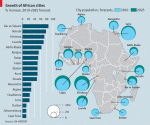
How Do Air Pollution and Urbanization Affect and Respond to the Local Climate?
THE CLIMATE OF A PLACE is a combination of the regional atmospheric conditions, such as those expressed by the Koppen climate classification, and local effects caused by topography, local wind directions, pollution, and other factors. These result in local variations, commonly called the local climate or the microclimate. The local climate is greatly influenced by […]

Cities and Urbanization
he image of Africa as a continent of traditional villages and small towns has never been correct. Africa has always included both highly urban and rural settlements. However, its cities have grown dramatically in recent years, and some researchers who study population trends have predicted that by the early 2000s about half of all Africans will live in urban areas. […]
The Persistence of the State in Chinese Urbanism
It is clear that Chinese urbanism has evolved differently under different historical contexts. It has always contributed to state formation while reflecting the national concerns of the period in question. What sets Chinese urbanism apart from the urbanisms elsewhere is the persistently strong role of the state in shaping its character that began with China's first cities in the […]
Multiplex Urbanism in the Reform Era
China's dramatic urban transformation since the 1978 reforms is a consequence of the interplay between exogenous and endogenous forces at global, national, and local scales. As elsewhere, globalization and neoliberalism have strongly impacted the Chinese economy, but major endogenous policy shifts have been more important in effecting changes in the Chinese city, including the initiation of the policies of […]
Socialist Urbanism (1949–1978)
Socialist urbanism in China was created very quickly during the first three decades of Communist rule. From 1949 to 1978, cities served two major functions. First, they continued to serve as centers of national and local administration, a function that directly affected their growth. Second, cities played a passive supporting role in China's centrally planned socialist industrialization, serving essentially as spatial containers […]
The Arrival of the West and Modernist Urbanism (1840–1949)
Urbanism in China experienced a dramatic change in the mid nineteenth-century when increasing numbers of Western traders arrived in China demanding expanded trade along the China coast, which precipitated the Opium War (1839–1842) between the British and Chinese empires. China's loss of the Opium War and other subsequent wars with foreign powers resulted in a series of unequal treaties that forced […]
Administrative and Commercial Urbanism (770 BC–AD 1840)
Childe's key criteria defining early cities in the Old World show clearly the importance of economic production and trade in the rise of its early cities, and economic factors have remained dominant in subsequent Western urban history. In China, during the Zhou period (c. 1122–256 BC), a politically fragmentary era with many independent states contending for territory and superiority, […]
Neolithic Settlements and Incipient Urbanism (c. 5000–770 BC)
As in other parts of the world, early Chinese towns evolved from villages. During the Middle Neolithic era (c. 6500–5000 BC), large sedentary villages with a few hundred people based mainly on agriculture and animal domestication had emerged. Widely distributed in China, many of the villages were surrounded by circular ditches and walls constructed with the hangtu (tamped earth) technique, whereby layers […]
Chinese Urbanism
Cities are complex spatial entities consisting of economic, social, political, and cultural dimensions that differ significantly in different cultures, where they tend to undergo varying patterns of transformation over time. Cities and states are dynamically related and mutually constituted, with the former often embodying the essence of the latter. This is especially true in the case of China. Relative to other […]
Anti-Urbanism
Introduction: 100% Urban Proof Origins: The Good Life Dislodging the Good Life, Disrupting the Rural Case Study: Edward Hopper's New York

urbanization
URBANIZATION IS THE process by which large numbers of people become permanently concentrated in relatively small areas, forming cities. The definition of what constitutes a city changes from time to time and place to place, but it is most usual to explain the term as a matter of demographics. The United Nations has recommended that countries regard all places with more than […]